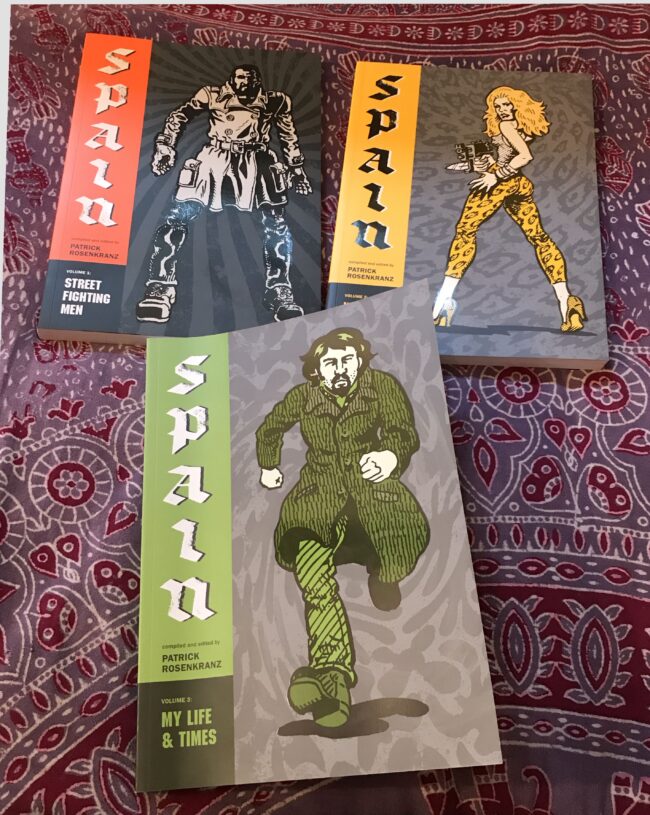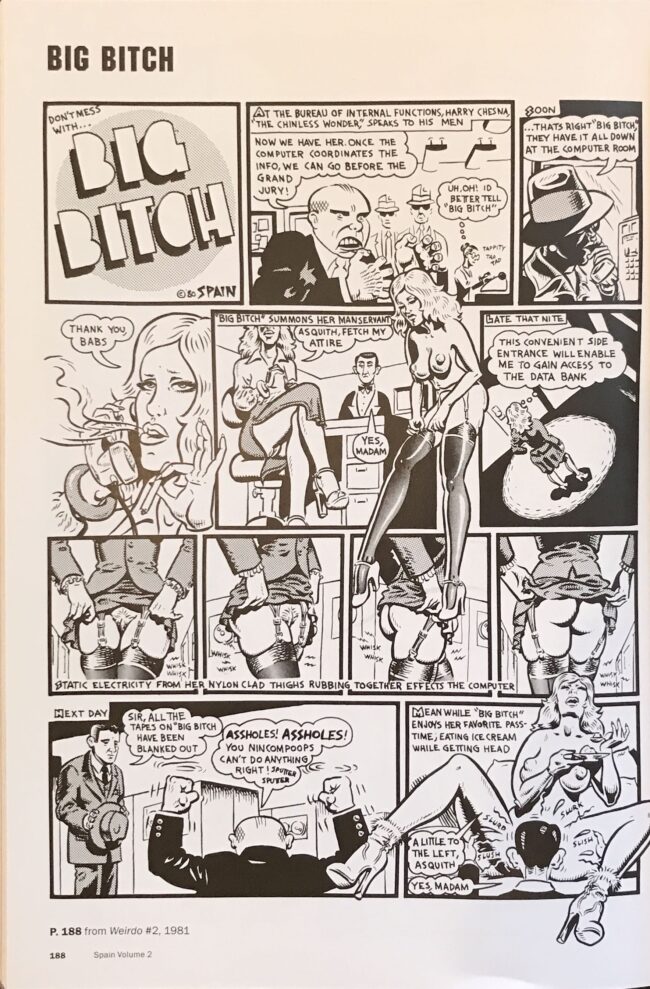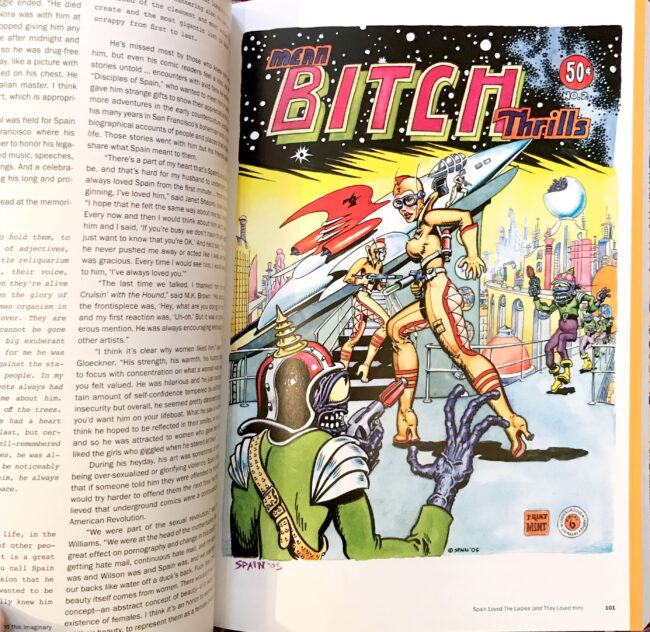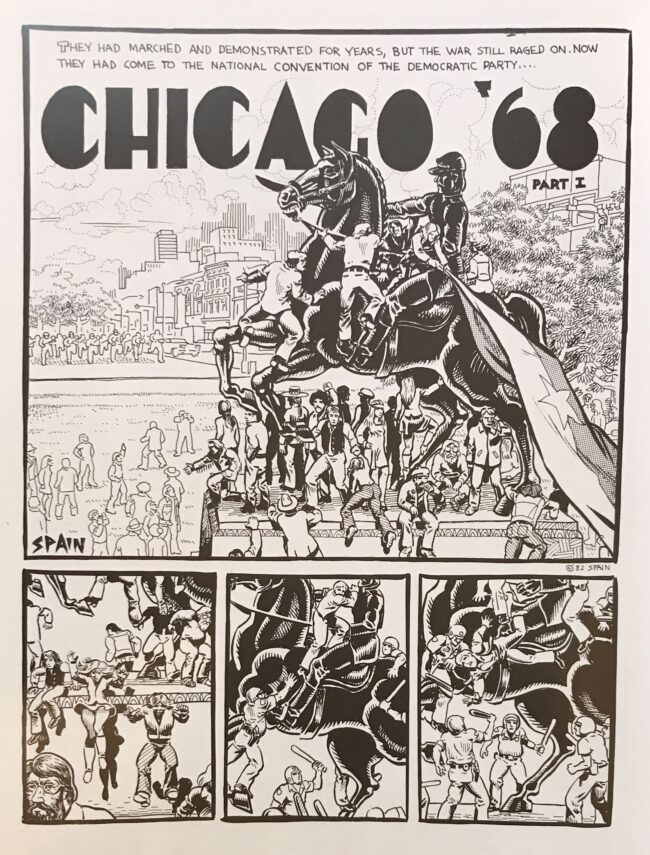"On the other side of the world members of our generation were sent to kill people who had done us no harm by rulers who knew the war in Vietnam could not be won. Somehow we helped to end the slaughter and the world rocked on. I moved to California. Janis Joplin took me out for a date. For a while it almost looked like you could make a living doing underground comics." - Spain Rodriguez, "I've Seen the Best of It!" (2002)
Influential cartoonist Manuel “Spain” Rodriguez died in 2012, but his comics are more prevalent than ever. Late 2020 saw the arrival of volume three in a planned five-volume, approximately 1500-page retrospective of Spain's life and work. Bad Attitude: The Art of Spain Rodriguez, a feature documentary film made by Susan Stern, Spain’s widow, premiered in February 2021. Both projects are superbly done, among the best work I've ever seen about comics and cartooning.
Consider this: it has been less than a decade since we lost Spain and not only are his legacy and legend coming into sharp focus, the posthumous books and film about him are remarkably ambitious, honest, and artful. I think the integrity and rigor of these projects reflects something extraordinary about Spain himself, that his life and work would inspire others to such heights.
As we learn in Stern's documentary, Spain could connect with people even when—or perhaps especially when—their values were in conflict with his. As a youth, he was part of a gang considered the toughest in the city, according to a retired Buffalo, New York policeman who remembered Spain and his gang. I love the interviews with the now aged, battered, scarred members of the Road Vultures Motorcycle Club in which it is made clear Spain won their respect with his art as much as his "club spirit" (which involved putting the boots to enemies and usually wrecking a neighborhood bar in the process). Instead of hiding his ability to draw, which could have been seen as too sensitive or weak, Spain earned acceptance for his artistic nature and elected himself the club's Minister of Propoganda. He also worked to instill in the street toughs his liberal, Marxist views.
Watching Stern's documentary, I got the sense that Spain's narrative is in large part about repeating this pattern over and over - becoming a valued part of a social structure when at first he was an outsider. Whether it was street toughs, people running a small underground newspaper in New York, a group of wildly disparate artists and cartoonists that had a certain "bad attitude" in common, leftist political groups, or San Francisco's Mission District community, Spain was able to make a place for himself in these worlds and in so doing, changed them all.
The goateed, mustachioed Latin-American cartoonist with the wild mane of hair (Spain's mane is a visual essay in itself in Stern's documentary, going from jet black, to streaked with gray, to full gray, to sparse and ugly, and then finally a pearly nimbus cloud around his depleted frame) was a ground-breaking artist as one of the leaders of the 1960s-70s Underground Comix movement, a cultural wellspring whose importance to our culture has yet to be fully understood and appreciated. One thing is clear, though: without Spain and his cartooning cohorts, comics today would be very different. Maybe the Revolution wasn’t televised, but it was cartooned … and Spain is one of the select few of his generation who showed us the way.
With all this unprecedented—and somewhat head-spinning—access into Spain’s life and work, a new perspective emerges and I am struck by a new realization about Spain I never had before.
Turns out, Spain was fearless. Huh. I didn’t know that. I guess that sounds pretty weird, given Spain’s macho notoriety and bold visual style. Let me explain. A lot of times when I see testosterone mixed with India ink on the page, as in Spain's art, I think it is a cover-up, a facade to hide behind, or a fantasy. I guess I always kinda wondered if that might be the case with the artist who drew so many stark, bold, 3D images of tough-as-shit men and women. But now I know: Spain was fearless. He put his spirit on the page.
I don't mean he was fearless because, at the end of his life when he was very ill, he didn't make a big deal of it at all, as Gary Groth and other friends of his speak about on camera in Bad Attitude.
And, I don’t mean Spain was fearless because, in his youth, he was a Nazi-stomping, street-fighting outlaw who was part of an inner-city motorcycle gang. Yeah, he was tough. As Susan Stern, says in a story recounted in “Forty Years in the Mission District,” an essay by Patrick Rosenkranz: “[Spain] wasn’t the kind of guy who sold wolf tickets. If he told you he was going to punch you, you got punched.”
Rosenkranz’s essay introduces My Life and Times: Spain Volume 3 (2020), the third in a planned deluxe five-volume collection of Spain’s art and comics published by Fantagraphics. Rosenkranz's Spain series is one of the more exceptional comics-related projects of the 21st century. When have we seen an approximately 1500-page, multi-volume, impeccably curated series framed with insightful essays and oral history accounts devoted to a modern cartoonist?
Getting one’s arms around a lifetime of work by a prolific, groundbreaking cartoonist like Spain Rodriquez is a monumental task and there is no one better suited to this than Patrick Rosenkranz, chronicler of the American Underground Comix scene since 1969. Rosenkranz wrote the best history available of the movement (Rebel Visions: The Underground Comix Revolution 1963-1975) and has compiled and edited recent books on Jay Lynch and S. Clay Wilson.
Even so, Rosenkranz has a mountainous challenge with the Spain series. Throughout his 72-year lifespan, Spain created a massive amount of comics and art. He was a dedicated visual storyteller and graphic artist; always improving, always working. In Stern's documentary, we see him at the drawing board, designing a gorgeous-looking poster for a Woody Guthrie event and telling us he does a lot of commercial artwork, saying, "I have to eat."
Even more daunting than locating the scattered work and now-rare publications that contain Spain comics and art are the monumental tasks of organizing, cataloging, and deeply studying it to develop critical understanding. Rosenkranz was a personal friend of Spain's, and this allows him to give the reader singular insight into the mythic cartoonist. However, closeness to the subject could also be a hindrance in gaining objectivity. Not so, in Rosenkranz's case. While his series celebrates the art of Spain, the curation and essays in his series do not shy away from showing and examining the problematic nature of the unapologetic chauvinism and violence in Spain's comics, and it is a subject I would like to see more discussion about. Why is it, for example, that we shy away from reprinting the racist comic strips of, say E.W. Kemble—a significant cartoonist from the early 20th century (he illustrated Huckleberry Finn, for one notable accomplishment)—and yet it seems okay to reprint and celebrate the transgressive undergrounds. Do we have a double standard at play? I suspect embracing our culture, warts and all will always be a problematic and unfair endeavor.
Susan Stern's documentary takes a harder look at the difficulties of fully appreciating Spain's art. Susie Bright, Trina Robbins, and others comment on the disturbing psycho-sexual and violent aspects of Spain's comics. Holding up a fantasy nude portrait of her by Spain, Stern asks “Did I make this film to defend Spain or to defend myself?” At one time a member of a woman's group that barred men, Stern is aware of the apparent contradiction between her feminist values and her 30+ years as the partner of a man who loved to objectify women's bodies in his art and was famous because of it. She admits, "I loved the way he drew me."
Women are the subject of volume two of the Fantagraphics Spain series. Rosenkranz has such a good handle on his subject he has been able to organize his five volumes by themes instead of a more typical chronological presentation. I applaud the thematic structure of this series because it ultimately places more emphasis on the work itself than the artist, which seems right to me. Conversely, Bad Attitude is much more about Spain himself, which makes the film and the books complementary to each other.
Where the first two volumes of this Spain-bang focused on ass-kickin’ males (Street Fighting Men: Spain Volume 1, 2017) and nympho-maniacal strong femme fatales (Warrior Women: Spain Volume 2, 2018), the recently released My Life and Times: Spain Volume 3 collects the best of Spain’s many autobiographical stories.
I’m hoping future volumes will include Spain’s seminal 1966 proto-underground comic, Zodiac Mindwarp. I'd also dig an essayed reprint of his masterful graphic novel adaptation of William Lindsey Gresham’s 1946 novel, Nightmare Alley. The grim carny saga (made into a classic noir movie in 1947 with a new film version coming soon from Guillermo Del Toro) was slated to be the third volume in the Neon Lit comic book series Bob Callahan and Art Spiegelman were packaging for Avon Books in the early 1990s (the first two books were adaptations of Paul Auster's City of Glass by Paul Karasik and David Mazzuchelli and crime novelist Barry Gifford's Perdita Durango by Callahan and Scott Gillis). Fantagraphics published Spain's book in 2003. It is now long out of print and commanding collector prices online. Incidentally, Spain's 1998 memoir story, "Carney," strongly resonates with the Gresham tale. The story is in My Life and Times: Spain Volume 3, and that is the kind of fun one can have with a multi-volume retrospective like this one that lays it all out.
 In the books, amid hundreds of pages of rare, restored art, Rosenkranz also provides themed essays that tell Spain’s story in shared anecdotes from people in his life (many are well-known cartoonists and artists) and provide all the background needed. Thus we get well-written, deeply researched essays on Spain’s time in the Road Vultures Motorcycle Club, an essay on the early underground press, an exploration of Spain’s relationships with women (was he a sexist or a feminist?), his role as a civic leader in San Francisco’s Mission District, his working methods, and a piece on his Blab! memoirs.
In the books, amid hundreds of pages of rare, restored art, Rosenkranz also provides themed essays that tell Spain’s story in shared anecdotes from people in his life (many are well-known cartoonists and artists) and provide all the background needed. Thus we get well-written, deeply researched essays on Spain’s time in the Road Vultures Motorcycle Club, an essay on the early underground press, an exploration of Spain’s relationships with women (was he a sexist or a feminist?), his role as a civic leader in San Francisco’s Mission District, his working methods, and a piece on his Blab! memoirs.
I like the design of these books, too. There are numerous smart design choices, such as running a full-color bleed strip on the outside edge of the essay pages, making them very easy to find. I dig the placement of S, P, and A in the same place on the spines (presumably the last two volumes will have spines adorned with I and N). It would have been nice if they managed to use Spain’s own lettering instead of a computer font, but that is a tiny nitpick. The page size is appropriate for the material, the restorations are superb, the color pops on the coated paper stock, and the presentation more or less accurately recreates the originally intended context (meaning, no crazy stuff like useless pages of enlarged details, crazy collages, or otherwise altered art that makes it impossible to understand what the artist was trying to accomplish, thank you very much).
[Speaking of design concerning Rosenkranz’s work, it is worth owning both the out-of-print 2002 hardcover and the 2008 trade paper editions of his Rebel Visions: The Underground Comics Revolution 1963-1975 (both published by Fantagraphics). A side-by-side comparison of the two volumes reveals a complete redesign with different (and in most cases, better) art. Carrie Whitney’s original design has some nice touches to it, such as the year related to the text in the upper right corner. This provides needed orientation in the dense text. Her design is clean with wide margins and thoughtful formatting that breaks the text up some, which helps with readability. The 2008 trade paper edition utilizes a new book design by comics historian Greg Sadowski (most recently writer and producer of another revelatory multi-volume series devoted to a cartoonist—Creeping Death From Neptune: The Life and Comics of Basil Wolverton Volume 1 and Brain Bats From Venus: The Life and Comics of Basil Wolverton Volume 2). Sadowski’s design is more dynamic, but the text kind of clumps together in one huge lump (the text is virtually identical to the first edition’s, with some updates and a few missing sidebars). The choice of font for the sub-heads resonates with Sixties San Francisco psychedelic pop art lettering but is a poor choice because it puts decoration over readability. And, for some reason, the endnotes – which cite the source of all the quotes in the book, are not included in the trade paper design, a grave omission. However, the art selection is much improved in the 2008 edition and this alone makes it worth seeking out. I admire Sadowski’s book designs in general. The idea of fmoving the introduction to the back of the book and turning it into a dense, detailed, small print, lightly illustrated notes section in the back of the book, as he does with Four Color Fear: Forgotten Horror Comics of the 1950s and a few other titles is an excellent innovation because it allows comic reprint books to please the public as much as possible and yet still earmarks some pages for much-needed comics scholarship.]
Rosenkranz’s Spain books are printed on coated paper. While generally coated stock makes reprints of older color comics look too dissimilar to the original presentations for which they were designed and thus corrupts the artist’s work, in this case, the use of shiny paper is a wise choice because the art in these books hails from a more modern era and the majority of it is in black and white. The thick, shiny paper makes Spain’s blacks (and he was great at spotting his blacks) so dark and glossy you can almost smell the Brylcreem and motorcycle grease in his comics.
Speaking of Spain’s use of black, I recently found myself admiring page two of Spain’s classic 1995 short story, “Cruisin’ with the Hound.” The only large solid blacks on this page are reserved for the color of Jocko Reese’s stylish shirt. This choice is in perfect harmony with the narrative flow, which is about how Jocko stood out from the pack with his singing.
I also want to say something about the organization of the material in the Spain book series. In addition to carving up the body of work into themes, the books are well-organized within each overarching topic. For example, volume one groups all of the Trashman stories together in chronological order into one 179-page section entitled “The Complete Trashman.” The thinking behind all of the groupings reflects an understanding of both Spain’s overall body of work and also how readers can best access it. For example, instead of spreading Big Bitch stories across all five volumes, they are collected together into a 100-page section. Volume 3, by contrast, has a section that blends stories from Monte Beauchamp’s Blab! and Special Edition issues of The Comics Journal because they are all memoirs. The chronological presentation of these true stories is important because there are some lines of continuity that only make sense when you read the stories in the order Spain made them.

Most of the just-released Volume 3’s comics detail Spain’s adventures as a young man, but it also includes sections of astonishing posters done for the San Francisco Mime Troupe, selections from Spain’s sketchbooks, and unpublished “fantasy” comic book covers. These surprising sections plus the accompanying essays reveal less obvious aspects of this extraordinary artist: teacher, comic book student, political activist, partner, and friend. Taken together, this damn-near-perfect Spain retrospective paints a portrait in raunchy, rumbling, raw-black ink strokes of the kind of man Spain really was. And, among all the other stuff, it turns out he was fearless.
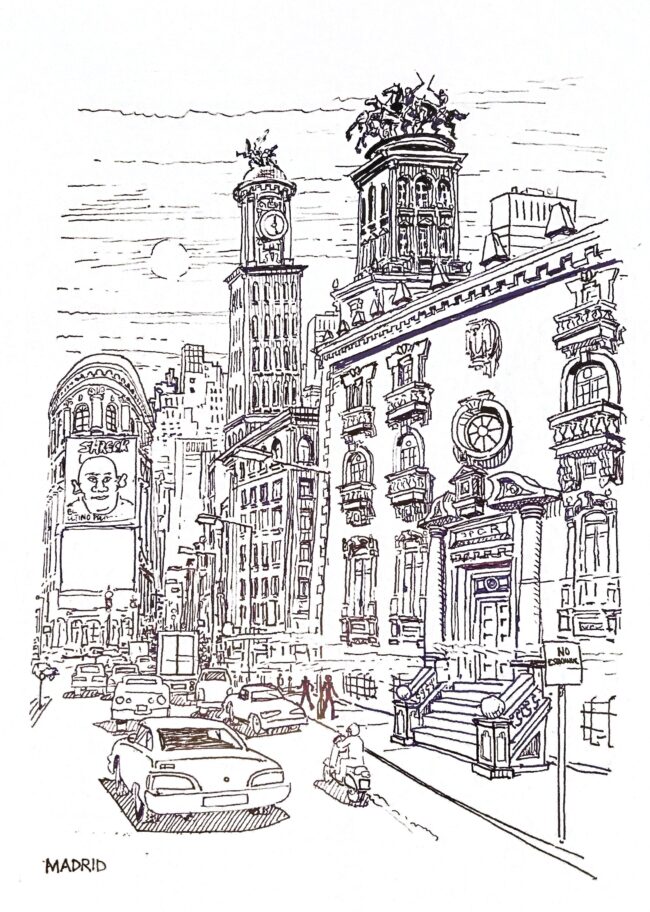
I also don’t mean Spain was fearless because he was a cartoonist who busted taboos and pushed boundaries with graphically sexual and violent comics and art, which he unapologetically published as one of the stand-out leaders—along with Robert Crumb and S. Clay Wilson, Trina Robbins, Robert Williams, Justin Green, Gilbert Shelton, and a few others—of the 1960s-70s counterculture underground comix movement. For those who don’t know, Spain was a card-carrying member of the exclusive group of Zap Comix artists and I think every issue contains his work (Street Fighting Men: Spain Volume 1 contains all six of his Road Vulture stories, about his time in a motorcycle gang in Buffalo, New York).
Neither do I mean Spain was fearless because he was a strident Marxist who stood up for the common person which he did from protesting America’s involvement in the Vietnam War in the 1960s right up to knocking on doors at age 72 to get out the vote (imagine opening your door and finding Spain there telling you to go vote: yes, sir!).
I don’t even mean Spain was fearless when he faced his alcohol addiction and gave up drinking at 34, which takes a helluva lotta guts to pull off.
No, what I mean is I have a new, bold, chiaroscuro understanding of Spain as a result of the current revival of his work. This is an understanding that has been available to me throughout my entire adult life (and part of my teens, too since I started reading undergrounds when I was 16) because Spain’s comics magically kept turning up in my hands. I never sought them out. Didn’t need to. They always found me, like a doo-wop song on the radio that drifts through the smoke of the grill in a late-night diner that grabs you and makes you forget for a few intense minutes your recently broken heart before you turn back to your BBQ pork sandwich, fries, and beer. But even so, I missed the obvious.
What I’m getting at is this: Spain was fearless because he never stopped creating. Never.
My Life and Times: Spain Volume 3 beautifully presents 272 pages of Spain’s comics and art and in so doing aptly demonstrates there was, until Spain’s death in 2013, a never-still river of comics, covers, posters, murals, and sketchbook drawings flowing from his pen. In “Spain’s Working Methods, “ a second essay included in My Life and Times, Art Spiegelman tells of visiting Spain and seeing a long comic book story spread out around a room and noticing random parts of it were either inked, penciled, loosely sketched, or blank. There was an eyeball inked here, a car tire there. When Spiegelman asked Spain if he always worked so chaotically, Spain told him he “figured as long as he kept his hand moving, it would all get done eventually.” And it did. And so did thousands of other pages. Why? Because Spain’s hand never stopped moving. He sat in front of his TV set at his family’s kitchen table and drew and drew. He was always drawing in sketchbooks.
When he was out in the world, he left behind him a trail of graffiti on walls. His wife filmed him tagging a wall and included it in Bad Attitude—a priceless moment. Robert Williams tells a story in the book about a time when he and Spain were interviewed at a radio station and, “while they weren’t looking, he started drawing all over their fucking walls and blew their minds. They were real upset over that. He had half the mural done before they got him stopped.” If any one story sums up Spain as an artist, this might be it.
It would be a mistake to regard Spain as a posturing, macho tough guy who loved drawing cool motorcycles and cars, naked women, and tough, angry men fighting. There is more. Much more. I see a depth and richness approaching literary standards (I’m thinking Charles Bukowski, Chester Himes, Mezz Mezzrow, or maybe John Steinbeck more than Hemingway, Dickinson, or Whitman).
For one thing, there’s a lot of top-quality humor in his stories, from flat-out slapstick to situational and character-driven comedy. Reading his autobiographical stories, one gets the idea Spain must have been pretty amused by a lot of what he experienced in life. In “Raw Meat” (1974), Spain and his thuggish pals indulge in a gang bang (with a willing woman going for a record), and what starts as a kind of Tijuana bible winds up as hilarious comedy as they think they are being chased by the police and flee the scene in a mad rush out of a window crawling over each other like panicked stampeding cattle, leaving behind a pair of cum-soaked undies on the sidewalk. In another story, Spain’s depictions of the brilliant humor of his friend Fred Toote, had me chuckling and shaking my head in astonishment (it’s “toot-ay,” not “toot,” as he insists in vain).
In stories like “Chicago “68” and “Down at the Kitty Kat,” Rodriguez is a keen chronicler of specific times and places. Whether he is providing gripping first-person reportage of a major event in modern American history or portraying the scene at a 1950s mixed-race Buffalo New York jook joint cathouse bar with live entertainment (The Vibra Harps, a vocal quartet whose leader is named Donald Duck), Spain puts the reader in the scene and creates a vicarious experience that is more than just cool, transgressive art.
That being said, I must admit that Spain’s art is cool and it is always what first draws me into his stories. Visually it’s sort of a cross between Wally Wood’s textured E.C. comics and traditional American tattoo art with bold outlines, solid dead-of-night blacks, and eye-kicking 3D imagery that jumps off the page and makes a serious lunge for your carotid. As a cartoonist, Spain had a singular “voice.” You can look at one panel, and even one part of a panel, and recognize his style. As the years went on, he got better and better, building a repertoire of artistic knowledge that earned him the respect of his peers. For example, Robert Crumb said, “He showed me stuff about perspective and anatomy that was very helpful.” Not many can lay claim to teaching Crumb something about drawing. (One of the best parts of Bad Attitude is watching Spain give his daughter, Nora, a drawing lesson.)
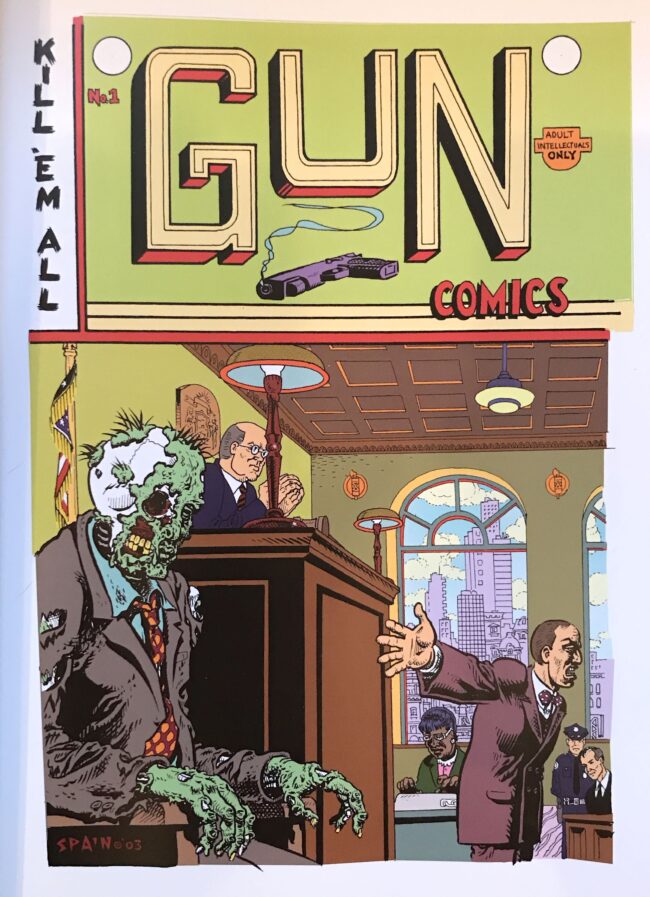
Spain, to paraphrase a motorcyclist’s motto, lived to draw and drew to live. It was his way of connecting to and making sense of the world. What impresses me so much is to learn that he was a “natural.” We learn from Rosenkranz’s interviews with the cartoonists who were Spain’s peers that Spain was one of those rare artists who vividly saw the drawing in his mind and so putting it on paper was almost a matter of tracing. This innate ability puts Spain Rodriguez in the class of cartoonists like Winsor McCay and Jack Kirby, also prolific naturals.
When I say Spain was a fearless artist, I don’t mean Spain was courageous—although he was that at times, too. Here's what I mean:
I’m talking about how Spain does not appear to have lost many battles with that inner resistance and fear that so many artists typically experience. He was remarkably unblocked. Perhaps it was because he kept his focus on making art. Oscar Wilde observed, “When bankers get together for dinner, they discuss art. When artists get together for dinner, they discuss money.” That doesn’t seem to be the case for Spain. In My Life and Times: Spain Volume 3, Rosenkranz quotes Maxine Weaver, a girlfriend of his in the 1970s, as saying, “I didn’t see Spain as ‘ambitious’ or very concerned with reputation, competition, or how the world was treating him financially. He calmly went on with the work he loved to do, and that’s what he talked about.”
Spain did not worry about being paid too little (in fact, he did a lot of pro bono, especially if one considers his tagging and unsolicited wall paintings). He didn’t ponder the movements of which he was a part (Underground, San Francisco art, rock poster art, and –as the book informs us—the 1970s Latino art movement, porn comics, to name a few) and he didn’t stop drawing to figure out his place in it all. He didn’t let self-criticism paralyze his hand and nor did he allow discouragement to dry out his ink pens. He didn’t let a hard story (and when it comes to well-drawn, well-told narrative comics, they are all hard) kick his ass. He kept his hand moving.
Although Spain must have had unproductive times they don’t appear to have slowed him down much. Spain wasn’t afraid to be an artist and to make the act of doing art the central focus of his life.
That’s not easy to do for most people, even the most gifted of artists. In Art and Fear: Observations on the Perils (and Rewards) of Artmaking (1993, Capra Press), co-authors David Bayles and Ted Orland write, “We’re all subject to a familiar and universal progression of human troubles—troubles we routinely survive, but which are (oddly enough) routinely fatal to the artmaking process. To survive as an artist requires confronting these troubles. Basically, those who continue to make art are those who have learned how to continue—or more precisely, have learned how not to quit.” Spain didn’t quit, as attested by the hundreds of pages of comics he left behind.
So, yes: Spain was a fearless cartoonist. Reading his comics in the spectacular new volumes shaped by Patrick Rosenkranz with that realization causes me to realize what a national treasure we have in the comics of Manuel “Spain” Rodriguez. For my money, Spain’s black leather Road Vulture Motorcycle Club jacket should be enshrined at the Smithsonian.
For now, Susan Stern has wrapped and stored it with his other clothes, toys, references books, comics, and art in a cataloged archive. And that’s good enough for now since we have this magnificent series of books and her new documentary roaring out onto the pop culture main street. I suggest jumping on the back for a ride, but hang on tight – Spain leans into those curves.
"From the funny business around the Kennedy assassination to the homosexuality and corrupting of J. Edgar Hoover to the movie star President, recent history sounds like a very bizarre science fiction story. If, in the fifties, I had told my dad what would happen in the last half of the 20th century he would have really thought I was nuts." - Spain Rodriguez, "Space Case" (2002)
Links:
A short clip from Bad Attitude: The Art of Spain Rodriguez with Trina Robbins and Art Spiegelman
Patrick Rosenkranz’s 2012 obituary of Spain
2012 Comics Journal review of Spain’s Cruisin’ with the Hound by Rosenkranz
Patrick Rosenkranz’s Comics Journal articles





